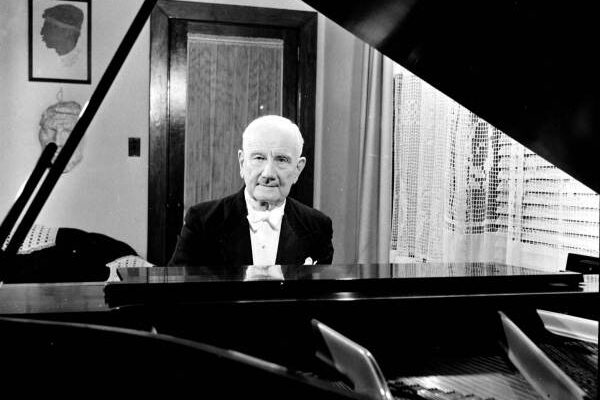In 2010, I was invited to give a presentation by Alan Walker at the Great Romantics Festival that he was organizing in Hamilton, Ontario, an invitation for which I am eternally grateful. It was my second time meeting the great musicologist and author, and on that occasion he gave me a CD of a 1966 BBC radio programme he’d produced about the great composer Ernst von Dohnányi’s incredible facility as a pianist, which of course I devoured with interest along with the wonderful books he presented me.
Last year, I was working with Walker to upload some recordings on YouTube and suggested that this programme might be of interest to many listeners and could perhaps be made available on the platform. Thus began a process over the course of several weeks of locating photographs of the many speakers in the programme and deciding how to arrange the presentation. The result can be seen (and heard) in the video below. Alas, long gone are the days when radio stations would invest extensive resources in the research and creation of a programme such as this, and I believe that these amazing productions need to be preserved. The entire presentation is absolutely terrific, with Walker’s narration and Dohnányi’s playing being beautifully balanced with engaging spoken testimonials by a number of musicians who share fascinating insights about the great composer-pianist’s mastery at the keyboard.
The process of preparing this video refreshed in my mind the degree to which Dohnányi’s music-making was on a far greater level than is generally appreciated, so I thought that it would be worthwhile to create this page to feature not only this fantastic documentary but a few of Dohnányi’s recordings so as to better appreciate his pianism. Soon after this feature was uploaded, Tom Jardine sent me one of the transfers he’d made of Dohnányi’s first HMV recording – although he does this work as a hobby, Jardine achieves some truly remarkable results, and the playing from this 1929 disc is more appreciable than ever thanks to the excellent transfer presented here.
One year prior to this HMV session, Dohnányi had recorded his own Marsch Op.17 No.1 and Beethoven’s Für Elise for Edison Bell in Budapest, as well as Mozart’s Piano Concerto No.17 for Columbia. The 78rpm disc presented below is from the first of the composer-pianist’s sessions for HMV: the previous day he had recorded Schumann’s Kinderszenen, the only work by another composer that he put on disc for that label. In the glorious transfer below, we can appreciate Dohnányi’s marvellous tonal colours, sumptuous phrasing, masterful pedal technique, wonderful timing, and refined dynamic gradations.
As stated above, the year prior to the above solo recording Dohnányi had recorded a superb account of Mozart’s Piano Concerto No.17 in G Major KV.453, in which he conducted the Budapest Philharmonic Orchestra from the keyboard. As the conductor-chairman of that orchestra from 1920 (a post he would hold until 1944), Dohnányi leads the group with absolute command while playing with great agility and elegance.
Naturally Dohnányi recorded a good deal of his own music. He put his own Variations on a Nursery Tune on record twice, first in 1931 with the London Symphony Orchestra conducted by Lawrence Collingwood and then a quarter century later, in 1956 with Sir Adrian Boult and The Royal Philharmonic Orchestra. Here is the first:
As a fascinating contrast, the pianist-composer’s second recording of his Nursery Tune Variations, made a full quarter century after the first:
In October 1950, Dohnányi produced two solo LPs for Remington Records, in addition to two discs accompanying violinist Albert Spalding (Dohnányi’s pupil Edward Kilenyi was Recording Director for the label until 1953). I chose to upload both records in a single clip on YouTube to better appreciate the stupendous pianism of this great artist. At the time of these sessions he was 73 years old and therefore not quite at his technical peak, yet he was still remarkably dextrous. Dohnányi preferred making complete takes in his sessions, rather than editing out single wrong notes or smudged phrases, in order for his interpretations to be more cohesive. These performances are wonderful examples of his pianistic genius, with a wonderful array of tonal colours, deft articulation, free timing within a steady rhythmic pulse, and expressive phrasing.
A number of concert recordings of an aging Dohnányi find him playing with great abandon. One fine example is this magnificent 1955 concert recording of him performing Chopin’s Impromptu No.2 in F-Sharp Major Op.36. The reading is filled with remarkable freedom of tempo and fluidity of phrasing, with a few moments that may seem over-the-top but which are wonderfully inspired, such as the pause before his dramatic entry into the middle section, which he plays with more fire and passion than I’ve ever heard from another pianist. The return of the main theme has an almost improvisatory quality to it. A truly magical traversal!
Another phenomenal live recording of the pianist comes from another concert in the late 1950s, a stunningly beautiful account of the Brahms Intermezzo in E-Flat Major Op.117 No.1. Aged about 80 at the time of the performance, Dohnányi plays with a marvellous singing sonority, wonderful voicing (those chords and resonant bass notes!), fluid legato, and impassioned phrasing.
As the documentary and these recordings demonstrate, Ernst von Dohnányi was indeed not just a great composer but a pianist whose skill was on par with many headlining pianists of his generation. It is to be hoped that his recordings at the keyboard will reach a wider audience and enable both music lovers and professional pianists alike to appreciate his remarkable artistry.
